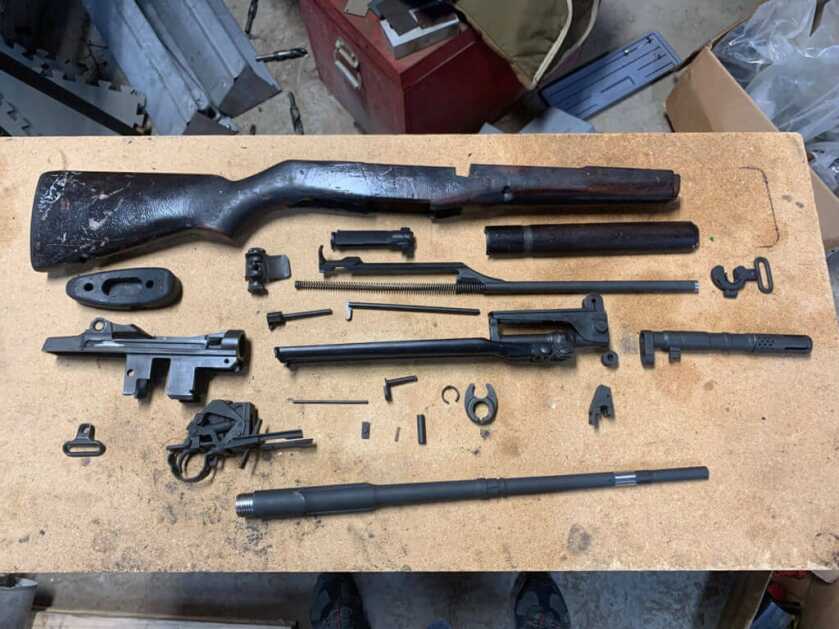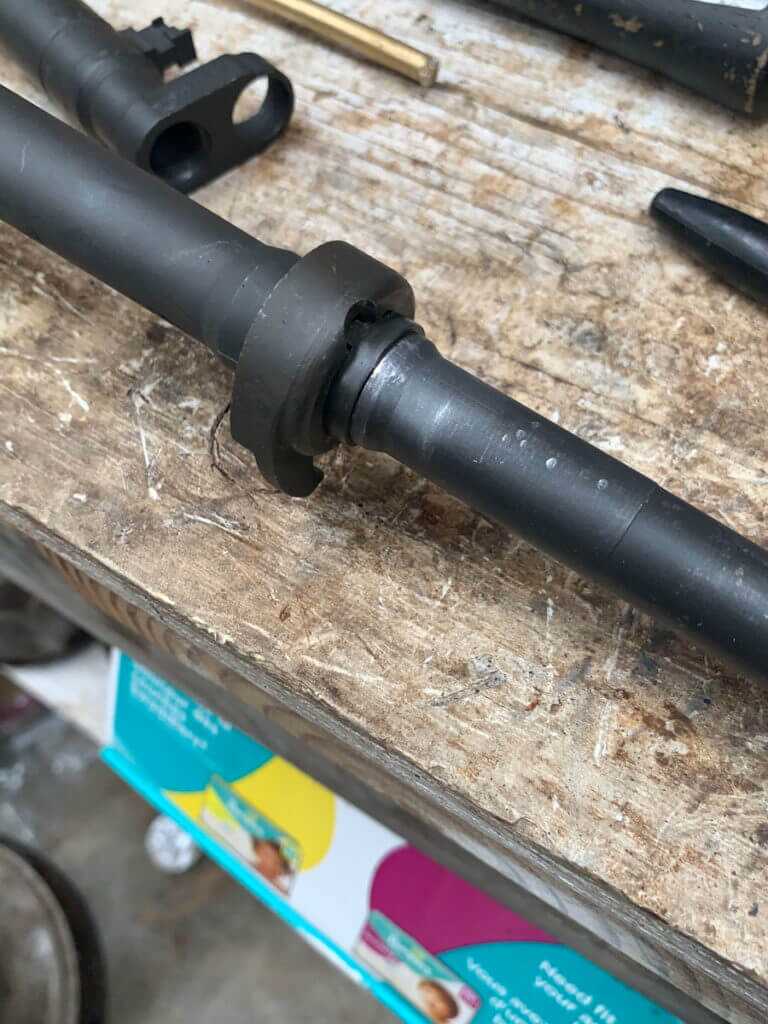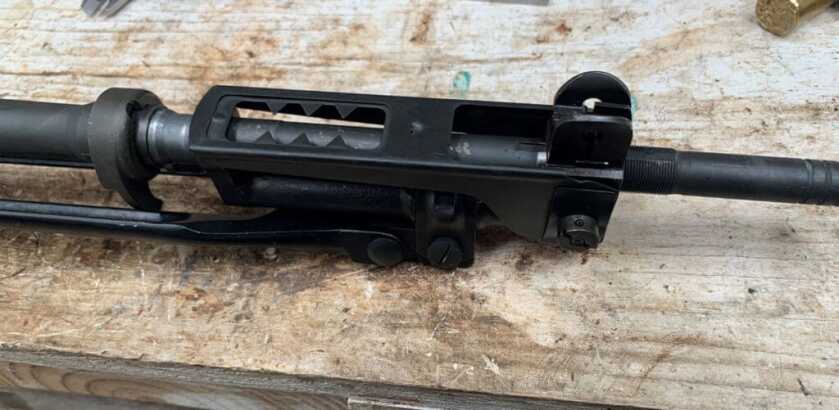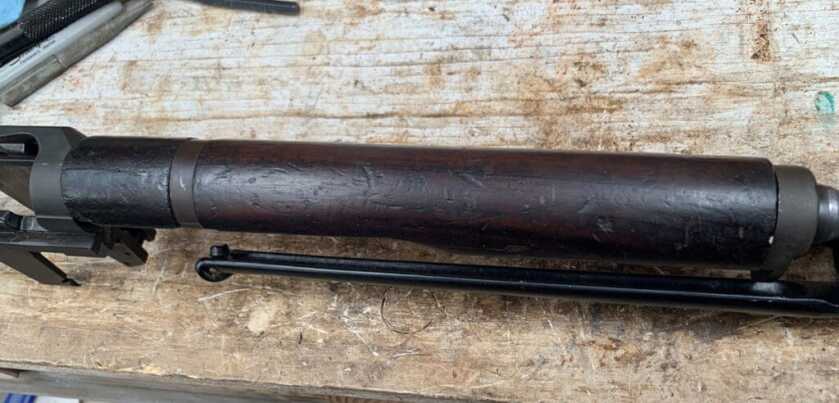After the Second World War, NATO was formed and its members decided to standardize their ammunition. They chose the 7.62 NATO round as the standard rifle round, and the various armies set to producing weapons in the new caliber. Italy, being a former Axis nation, was not overly affluent after the war. They chose to convert the M1s they had been supplied immediately post-war, rather than make whole new weapons, at least initially. Beyond the caliber conversion, they were converted to use a detachable magazine, and (for most models anyway) a combination muzzle brake/grenade launcher/flash suppressor was added. Some unique features added to the BM59 were geared towards fighting in extremely cold weather. The Italians added a foldable winter trigger that can be used without the removal of heavy mittens and a bipod to make it easier to shoot while lying in the snow. After Italian experiences on the Eastern Front in WWII, and the Carpathian Campaign in WWI, (both brutal, cold weather campaigns) it’s hardly surprising that they would add cold-weather features.
The first BM59 I saw was around the time of the 2012-2013 “panic”. I bought a very nice Pre-Ban Springfield Armory example (SN 0000663). Unfortunately, it was stolen along with a number of other firearms I had, and it has not been recovered to date. Fortunately, in the last few years, BM-59 parts kits started becoming available in the US. I was excited to see this, as I could finally replace the rifle I lost. I bought the parts kit from Centerfire Systems some time ago, but they’ve been out of stock for a while. However, Numrich currently has parts kits in stock as does Bowman Arms, and I have seen them available elsewhere. As it turned out, the parts kit was the easiest thing to acquire.

Receivers are a little bit difficult. I have heard of some BM59 receivers being available, but I have yet to find any recently. But all is not lost. The BM59 rifle is based on the M1, and the first examples were actually converted M1 rifles. So it is quite possible to modify an M1 receiver to BM-59 specs. I personally find the idea of cutting up an original, functioning M1 rifle to be something of a travesty, and I didn’t find any stripped receivers for sale at the time I was looking. So I bought an M1 Drill Rifle (which I discussed in a previous article) to obtain a receiver. I did the conversion work myself (which is detailed in a separate article), but it’s a fairly complex project. There are gunsmiths who do this work if you don’t have the means to do it yourself.
The barrel for this build came from Sarco. It’s what they’re calling an ITAL model barrel, which is the right barrel for this particular BM59 build. They seem to go in and out of stock. Unfortunately, BM59E barrels will not work on other BM59 models such as this one. Of course, if you’re building a BM59E, you can simply purchase a barrel. If you don’t want to wait, it is possible to modify a .308 M1 barrel, though this is a fairly significant machining project. Much like receiver conversions, there are some gunsmiths that will do the barrel conversion as well. There are different types of BM59 barrels and they do not interchange, so be sure of what you need for your particular build before you buy it.
A little bit on the legal side of this is probably in order. Anytime you build a firearm, make sure to comply with all relevant federal, state, and local laws. For a build like this, 922r compliance is required. 922r states that no more than 10 foreign parts off of a specific list of parts can be used in the assembly of a “non-sporting rifle”. Fortunately, a lot of BM59 parts are interchangeable with M1 parts, so this isn’t really too much of a hurdle. Some states may not allow assembly of a rifle in the configuration I am describing. If you are using a converted M1 receiver for this build, you may or may not be legal in states with “assault weapons bans” on the books. So make sure you know the rules in your locality before proceeding with a build similar to this one. Now, on to building!

The first assembly step is to lap the bolt to the receiver. A lot of times, M1 type rifles will only have 1 lug in contact. Obviously, this isn’t conducive to accuracy. So I lap my bolts. You should use a lapping fixture for this. I made a simple fixture out of the old barrel stub from the drill rifle. The lapping compound for this task should be 240-320 grit. It should be applied sparingly as it has a tendency to get everywhere. The bolt is installed (it should be stripped prior to this) and the outside lug lifted up and down slightly 25 times or so. Then you clean the lugs of the receiver and bolt and mark the backs of the bolt lugs. That way you can see how much lug contact you have by seeing how much of your marks are removed. Once you have good contact on both sides, you’re done. Make sure to clean all of the lapping compounds out of the receiver and off of the bolt.

Next comes installing and timing the barrel. Put the barrel in the vise, and screw the receiver onto it until its hand tight. Put a business card or something between the wrench and the receiver to keep the wrench from leaving marks on the finish. You need to screw the barrel in until the barrel is properly timed. I don’t know how much torque is required for barrel install on rifles like this, but it’s a lot. I use a couple of rods to help in timing the barrel. You install the gas cylinder and put a rod where the front sight slides on. And then put another rod on the receiver. There are several different surfaces on the receiver to use as reference points, but they vary a little bit. So pick one and make sure to stick with it. I typically slide the rod through the holes in the rear sight ears. The idea here is that the rods make it easier to see where you’re at when timing the barrel. When the rods are parallel, the barrel is timed.

Once you have your barrel properly timed, it’s time to finish and ream the chamber. BM59 barrels, just like M1 barrels, come short-chambered to allow you to install it on your receiver, time it, and still be able to have it properly headspace. Basically, the barrel maker leaves the chamber a few thousandths shallow. So we need to finish ream it to the proper depth. Fortunately, this does not require machine tools to accomplish. I purchased a headspacing reamer set from Manson Reamers. This consists of a “pull-through” chamber reamer, bushing, and a rod. The bolt is used to put light pressure on the bushing at the back end of the reamer while the rod is slowly rotated. This is a fairly delicate process, as we’re only talking about removing a few .001s, so take your time here and use plenty of cutting oil. You need to stop regularly to clean the chips off of the reamer and check your progress with a GO gauge. The chamber needs to be completely clean when you check it with the gauge, otherwise, you’ll get a false reading. When the chamber is to the proper depth, the bolt should completely close on a GO gauge and not close on a NO-GO gauge.


Next is installing the handguard cap. There are BM59 “builder” caps available from a couple of sources, and these attach with a roll pin, just like an M1. In retrospect, it’s probably worth spending the few extra dollars to purchase it. I decided to use the BM59 cap and clip that came with the parts kit. Put plainly, it’s a royal pain in the butt to install. It has to slide over a taper on the barrel and into a groove. After a few attempts, I figured out that I needed to fit the cap itself slightly by removing a little bit of material off of the part that contacts the barrel journal on the other side. This allowed the cap to sit slightly further back, and then the clip would go into the groove like it was supposed to. So, if you’re going to use the cap and clip from the parts kit, figure on doing some fitting. You’ll also need some tubing of some kind with a ¾” hole to push the clip over the taper and into place.

The gas cylinder goes on next. It isn’t just going to slide on, as it’s supposed to be tight. Unlike the M1, where the front handguard stops the gas cylinder, there really isn’t anything there on the BM59. If you push it on too far, the oprod won’t go in. So get it close and check with the oprod to make sure that it will go into place. It’s not the end of the world if you have to push it back out a little. But, you don’t want to take it on and off more than you have to. Removing it excessively will make it loosen, which is not good for the gas seal. At any rate, after that, you install the muzzle brake and the gas plug. The muzzle brake has the “gas lock” built into it.
The rear sight assembly is pretty straight forward, as it’s basically identical to the M1. After you assemble it, check it to ensure it’s properly tensioned. Then I installed the front magazine catch. The pin for it is supposed to be pretty tight. I put some anti-seize on it, and I managed to use a hammer and a punch to install it. The bolt catch is pretty easy to install. The pin that comes with the parts kit reportedly works its way out while the weapon is fired because of the gap in the stock. On the original military rifles, it was held in place by the full auto components that filled that gap in the stock. Fortunately, there is an easy fix for this problem. An AR15 dust cover pin is the right size, and it’s long enough that the stock will keep it from walking out.

I installed a stripper clip guide on my build. It just fit into a dovetail on the receiver (I cut this when I converted the receiver). Different guides attach by different means, and if your receiver isn’t cut for one then you’ll have to modify it. I do not believe the BM59E originally had one. The pre-ban Springfield BM59 I lost, had a clip guide. So I wanted one on this build. The idea has some merit, as it allows you to reload or “top off” a magazine without having to remove it from the rifle. BM59 magazines are a little more expensive than some other comparable models, and the stripper clip capability can allow you to get by with fewer magazines.

Installing the handguard is another task that requires some care. If you attempt to force it into place, you will likely crack or even completely break it. I had to do some fitting to get mine to go into place as it should. I carefully removed material on the front side (because it isn’t visible after assembly) until it would fit. The rest of the assembly for these is just like an M1 or M14 type rifle. Install the bolt, oprod, spring, and guide. Then put the action into the stock, install the fire control group assembly, and then rotate the trigger guard up and lock it into place.

Before test-firing a new build, function test it with dummy rounds to ensure that it’s working properly-particularly the fire control group. When you go to test fire it, some precautions should be taken. Don’t just load up a full magazine and start shooting. Load and fire one round. Check the casing and make sure it looks OK. Then load and fire 2 rounds. If everything works properly and the casings look OK, do the same with 3. Once you’ve fired 3 consecutive rounds without incident, you’re probably in the clear. I would suggest you bring the tool to remove the gas plug with you when you test fire. If your rifle doesn’t cycle, the gas cylinder is probably not properly located over the gas port. Remove the gas plug, screw the muzzle brake down another rotation (it will move the cylinder back), and you should be good to go.

The BM59 is a unique and interesting battle rifle. Building one is a challenging and rewarding project. It is not exactly a beginner’s project. But it is quite doable for someone with the right tools and the knowledge to use them. It is a little bit tricky to acquire all of the necessary parts, but it is quite possible. If you’re into M1s or battle rifles in general, you will enjoy building a BM59.

When you say m1 , it should say m1a1
The Italians actually modified M1 rifles to make the original BM59 rifles. The receivers were machined to take detachable magazines. In the first BM59s, they actually shortened M1 barrels on the chamber end(because 30-06 is obviously a longer cartridge) and modified original stocks to work as well. Overall, very interesting concept.
Another fine article- good job Chris!!!!
The BM59 – what the M-14 should have been, but wasn’t.
I grit my teeth every time I read one of these articles, because you have to be so careful not to go too far with the machining, and fitting. If you can get the parts for a cheap enough price; it is arguably a better rifle than a standard M1A1. Some vets I’ve talked to, who served in Italy, claimed it was the best battle rifle in the world for its day. I personally believe them, because the original WW2 weapon was so reliable and successful, where as some Vietnam vets tell me they considered the M14 a piece of junk. These were guys who were in hairy fire fights, and actually loved the M16 when it came along. They knew if you didn’t select your magazine and clean the weapon religiously while the bad powders were coming through the supply chain, you could be in trouble with it too.
I’m sure everyone has an opinion, but I base mine of veteran experience. I originally fell in love with the M14 in ROTC; but my TAC NCO who specialized in penetrating enemy camps at night and arranging ambushes, said he’d never go out with an M14, and he was the first Vietnam vet to tell me they were a piece of junk – something was always breaking or failing in the operating rod system IIRC. He loved the then new M16A1 and used it exclusively for ambush and LRRP excursions.